-
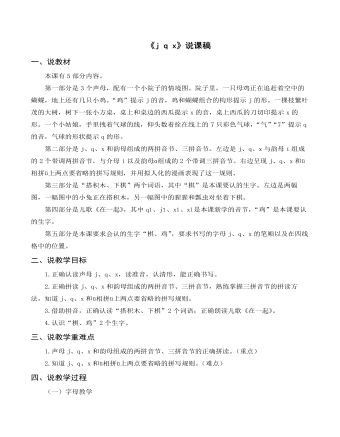
部编人教版一年级上册《j q x》说课稿
本课有5部分内容。第一部分是3个声母,配有一个小院子的情境图。院子里,一只母鸡正在追赶着空中的蝴蝶,地上还有几只小鸡。“鸡”提示j的音,鸡和蝴蝶组合的构形提示j的形。一棵枝繁叶茂的大树,树下一张小方桌,桌上和桌边的西瓜提示x的音,桌上西瓜的刀切印提示x的形。一个小姑娘,手里拽着气球的线,仰头数着拴在线上的7只彩色气球,“气”“7”提示q的音,气球的形状提示q的形。第二部分是j、q、x和韵母组成的两拼音节、三拼音节。左边是j、q、x与韵母i组成的2个带调两拼音节,与介母i以及韵母ɑ组成的2个带调三拼音节。右边呈现j、q、x和ü相拼ü上两点要省略的拼写规则,并用拟人化的漫画表现了这一规则。第三部分是“搭积木、下棋”两个词语,其中“棋”是本课要认的生字。左边是两幅图,一幅图中的小兔正在搭积木,另一幅图中的猩猩和瓢虫对坐着下棋。第四部分是儿歌《在一起》,其中qǐ、jī、xǐ、xì是本课新学的音节,“鸡”是本课要认的生字。第五部分是本课要求会认的生字“棋、鸡”,要求书写的字母j、q、x的笔顺以及在四线格中的位置。二、说教学目标1.正确认读声母j、q、x,读准音,认清形,能正确书写。2.正确拼读j、q、x和韵母组成的两拼音节、三拼音节,熟练掌握三拼音节的拼读方法,知道j、q、x和ü相拼ü上两点要省略的拼写规则。3.借助拼音,正确认读“搭积木、下棋”2个词语;正确朗读儿歌《在一起》。4.认识“棋、鸡”2个生字。
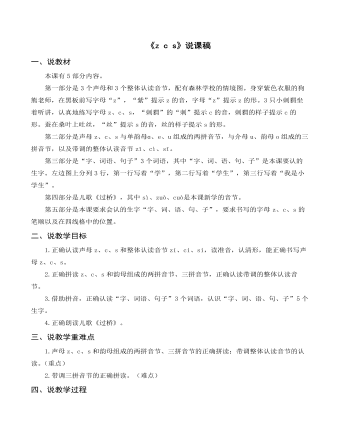
部编人教版一年级上册《z c s》说课稿
一、说教材本课有5部分内容。第一部分是3个声母和3个整体认读音节,配有森林学校的情境图。身穿紫色衣服的狗熊老师,在黑板前写字母“z”,“紫”提示z的音,字母“z”提示z的形。3只小刺猬坐着听讲,认真地练写字母z、c、s,“刺猬”的“刺”提示c的音,刺猬的样子提示c的形。蚕在桑叶上吐丝,“丝”提示s的音,丝的样子提示s的形。第二部分是声母z、c、s与单韵母ɑ、e、u组成的两拼音节,与介母u、韵母o组成的三拼音节,以及带调的整体认读音节zǐ、cì、sī。第三部分是“字、词语、句子”3个词语,其中“字、词、语、句、子”是本课要认的生字。左边图上分列3行,第一行写着“学”,第二行写着“学生”,第三行写着“我是小学生”。第四部分是儿歌《过桥》,其中sì、zuò、cuò是本课新学的音节。第五部分是本课要求会认的生字“字、词、语、句、子”,要求书写的字母z、c、s的笔顺以及在四线格中的位置。
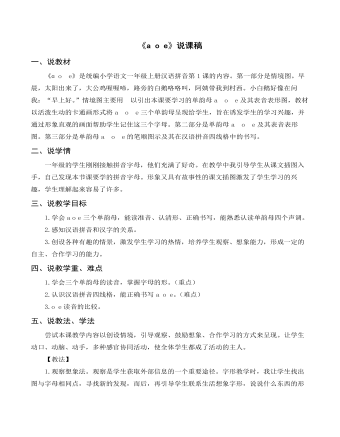
部编人教版一年级上册《a o e》说课稿
一、说教材《ɑ o?e》是统编小学语文一年级上册汉语拼音第1课的内容。第一部分是情境图。早晨,太阳出来了,大公鸡喔喔啼,路旁的白鹅咯咯叫,阿姨带我到村西。小白鹅好像在问我:“早上好。”情境图主要用?以引出本课要学习的单韵母a?o?e及其表音表形图,教材以活泼生动的卡通画形式将a?o?e三个单韵母呈现给学生,旨在诱发学生的学习兴趣,并通过形象直观的画面帮助学生记住这三个字母。第二部分是单韵母a?o?e及其表音表形图。第三部分是单韵母a?o?e的笔顺图示及其在汉语拼音四线格中的书写。二、说学情一年级的学生刚刚接触拼音字母,他们充满了好奇。在教学中我引导学生从课文插图入手,自己发现本节课要学的拼音字母。形象又具有故事性的课文插图激发了学生学习的兴趣,学生理解起来容易了许多。三、说教学目标1.学会a o e 三个单韵母,能读准音、认清形、正确书写,能熟悉认读单韵母四个声调。2.感知汉语拼音和汉字的关系。3.创设各种有趣的情景,激发学生学习的热情,培养学生观察、想象能力,形成一定的自主、合作学习的能力。

部编人教版一年级上册《江南》说课稿
三、说教学目标1.指导学生认识“江、南、可、等”9个生字。会写“可、东、西”3个字。学习新笔画“竖弯钩”“竖弯”。? 2.引导学生正确流利地朗读课文。背诵课文。感悟江南水乡的美景。? 3.培养学生热爱大自然的感情。四、说教学重难点1.让学生通过识字,能正确流利地读、背古诗。(重点)?2.感悟江南水乡的美景,培养学生热爱大自然的情感。(难点)五、说教法和学法教学是教师和学生互动的一个双边活动,在这个活动中教师是学习的组织者、引导者、合作者,而学生才是学习的主体,因此本节课我采用了“激、促、查、教”等教学方法,指导学生在“自主、合作”中学习,以达到“生成知识、运用知识”的目的。
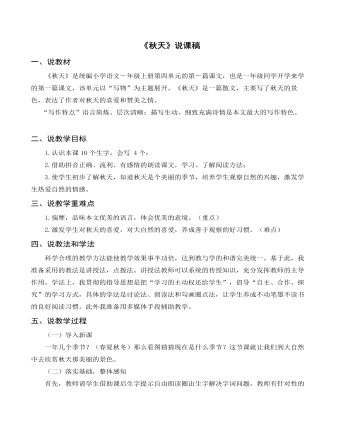
部编人教版一年级上册《秋天》说课稿
一、说教材《秋天》是统编小学语文-年级上册第四单元的第-篇课文,也是一年级同学开学来学的第一篇课文,该单元以“写物”为主题展开。《秋天》是一篇散文,主要写了秋天的景色,表达了作者对秋天的喜爱和赞美之情。 “写作特点”语言简炼、层次清晰;描写生动、细致充满诗情是本文最大的写作特色。 二、说教学目标1.认识本课10个生字,会写 4个;2.借助拼音正确、流利、有感情的朗读课文,学习、了解阅读方法;3.使学生初步了解秋天,知道秋天是个美丽的季节,培养学生观察自然的兴趣,激发学生热爱自然的情感。
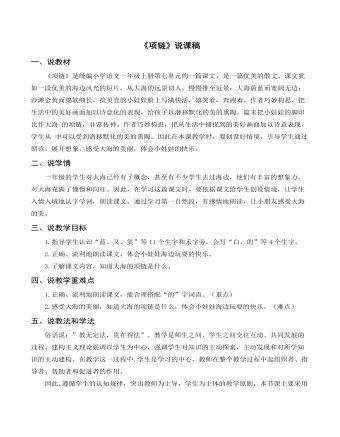
部编人教版一年级上册《项链》说课稿
四、说教学重难点1.正确、流利地朗读课文,能合理搭配“的”字词语。(重点)?2.感受大海的美丽,知道大海的项链是什么,体会小娃娃海边玩耍的快乐。(难点)五、说教法和学法俗话说:”教无定法,贵在得法”。教学是师生之间、学生之间交往互动、共同发展的过程。建构主义理论强调以学生为中心,强调学生对知识的主动探索、主动发现和对所学知识的主动建构。在教学这一过程中,学生是学习的中心,教师在整个教学过程中起组织者、指导者、帮助者和促进者的作用。? 因此,遵循学生的认知规律,突出教师为主导,学生为主体的教学原则,本节课主要采用学案导学、闯关游戏、小组竞赛的方式进行学习。教师主要为学生创设问题情境,引导学生在对话、讨论、交流中觅取新知,启发、点拨学生通过分析人物的心理描把握人物形象、领悟小说主旨。为了提高课堂学习效果,主要利用多媒体课件和学案来进行教学。
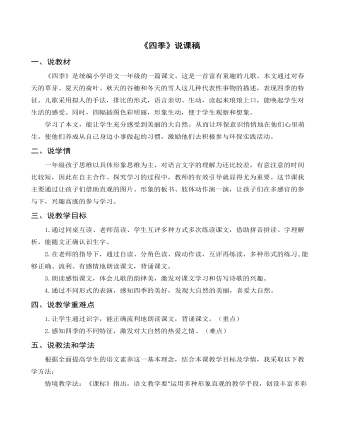
部编人教版一年级上册《四季》说课稿
五、说教法和学法根据全面提高学生的语文素养这一基本理念,结合本课教学目标及学情,我采取以下教学方法:情境教学法:《课标》指出,语文教学要“运用多种形象直观的教学手段,创设丰富多彩的教学情境”。本节课,我通过创设一定情境,激发学生学习兴趣,集中其注意力,拉近学生与文本的距离。以读代讲:本着“以读为本”的教学原则,让学生通过读对课文加深理解,并在图片美的直观感受下读出感情,学生就能进一步的感受感受到语句的优美。叶圣陶先生指出,“教师之为教,不在于全盘授予,而在相机诱导”。学习中突出学生的主体地位,让学生放开手脚,积极参与。本课我指导学生用如下方法进行学习:朗读感悟法:《课标》指出小学各年级的阅读教学都要重视朗读。要让学生充分的读,在读中整体感知,在读中有所感悟,在读中培养语感,在读中受到情感的熏陶。本节课,我让学生通过多种形式的读来感受文中蕴涵的情感。自主合作学习方法:合作学习,培养学生合作意识和自主学习能力。

部编人教版一年级上册《影子》说课稿
【说学法】1.合作学习法。以学生为本、小组合作、生生互助的形式来学习,培养学生在合作中取长补短,互帮互助的合作精神。 同组一起把生字读两遍。然后互相检查看看是否读准字音。并说说自已是怎样记住哪个字的,让学生感受合作学习的快乐。 2.朗读比赛法。为了达到正确、流利地朗读课文的目的。让学生利用多种形式读。如:同桌对读,个别读,小组读等方法,贯穿始终,读中悟,悟中读,收到以读代讲以读悟情的效果。 3.自主评价法。通过让学生自主评价,培养学生倾听,欣赏以及表达能力。从而使低年级学生从小养成学习语文的良好习惯。 五、说教学过程(一)谜语导入,揭示课题1.出示谜语,引出“影子”。? 你有我有他也有,黑身黑腿黑黑头。灯前月下跟你走,就是从来不开口。? (设计意图:猜谜语是小学生喜欢的活动。这个谜语不仅引出了课题,而且呈现了本课要学习的生字,可以给学生一个初步的认识。)
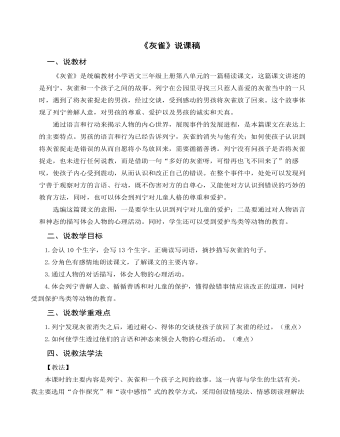
部编人教版三年级上册《灰雀》说课稿
一、说教材 《灰雀》是统编教材小学语文三年级上册第八单元的一篇精读课文,这篇课文讲述的是列宁、灰雀和一个孩子之间的故事。列宁在公园里寻找三只惹人喜爱的灰雀当中的一只时,遇到了将灰雀捉走的男孩,经过交谈,受到感动的男孩将灰雀放了回来。这个故事体现了列宁善解人意,对男孩的尊重、爱护以及男孩的诚实和天真。 通过语言和行动来揭示人物的内心世界,展现事件的发展进程,是本篇课文在表达上的主要特点。男孩的语言和行为已经告诉列宁,灰雀的消失与他有关;如何使孩子认识到将灰雀捉走是错误的从而自愿将小鸟放回来,需要循循善诱。列宁没有问孩子是否将灰雀捉走,也未进行任何说教,而是借助一句“多好的灰雀呀,可惜再也飞不回来了”的感叹,使孩子内心受到震动,从而认识和改正自己的错误。在整个事件中,处处可以发现列宁善于观察对方的言语、行动,既不伤害对方的自尊心,又能使对方认识到错误的巧妙的教育方法,同时,也可以体会到列宁对儿童人格的尊重和爱护。 选编这篇课文的意图,一是要学生认识到列宁对儿童的爱护;二是要通过对人物语言和神态的描写体会人物的心理活动。同时,学生还可以受到爱护鸟类等动物的教育。
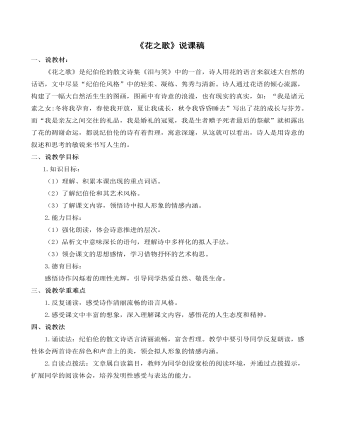
部编人教版六年级上册《花之歌》说课稿
一、说教材: 《花之歌》是纪伯伦的散文诗集《泪与笑》中的一首,诗人用花的语言来叙述大自然的话语,文中尽显“纪伯伦风格”中的轻柔、凝练、隽秀与清新。诗人通过花语的倾心流露,构建了一幅大自然活生生的图画,图画中有诗意的浪漫,也有现实的真实,如:“我是诸元素之女:冬将我孕育,春使我开放,夏让我成长,秋令我昏昏睡去”写出了花的成长与芬芳。而“我是亲友之间交往的礼品,我是婚礼的冠冕,我是生者赠予死者最后的祭献”就袒露出了花的凋谢命运,都说纪伯伦的诗有着哲理,寓意深邃,从这就可以看出,诗人是用诗意的叙述和思考的敏锐来书写人生的。 二、说教学目标 1.知识目标: (1)理解、积累本课出现的重点词语。 (2)了解纪伯伦和其艺术风格。 (3)了解课文内容,领悟诗中拟人形象的情感内涵。

部编人教版六年级上册《盼》说课稿(一)
【教材分析】《盼》是六年级第五单元的一篇课文。本文选自作家铁凝的第一本出版小说《夜路》,是一篇儿童文学类的小说。作者以孩子的视角,记述了得到新雨衣,渴望下雨到愿望实现——在雨中穿上了新雨衣的故事。用细腻的语言描述了小主人公情感和心理的变化,表现了童真童趣。【教学目标】1.疏通重难点字词的读音和写法。2.整体感知课文内容,把握故事情节,理清行文思路,感受小主人公因新雨衣而产生的“盼”。3.通过捕捉环境描写、人物的语言、动作、神态、对话等描写,来感受小主人公情感的变化。【教学重难点】通过捕捉环境描写、人物的语言、动作、神态、对话等描写,来感受小主人公情感的变化。【教学过程】核心问题:作者如何围绕一个“盼”字展开描写,表现小主人公的情感变化?
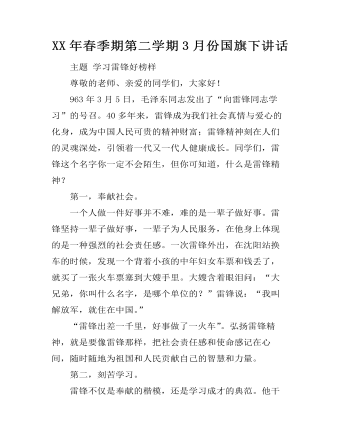
XX年春季期第二学期3月份国旗下讲话
主题 学习雷锋好榜样尊敬的老师、亲爱的同学们,大家好!963年3月5日,毛泽东同志发出了“向雷锋同志学习”的号召。40多年来,雷锋成为我们社会真情与爱心的化身,成为中国人民可贵的精神财富;雷锋精神刻在人们的灵魂深处,引领着一代又一代人健康成长。同学们,雷锋这个名字你一定不会陌生,但你可知道,什么是雷锋精神?第一,奉献社会。一个人做一件好事并不难,难的是一辈子做好事。雷锋坚持一辈子做好事,一辈子为人民服务,在他身上体现的是一种强烈的社会责任感。一次雷锋外出,在沈阳站换车的时候,发现一个背着小孩的中年妇女车票和钱丢了,就买了一张火车票塞到大嫂手里。大嫂含着眼泪问:“大兄弟,你叫什么名字,是哪个单位的?”雷锋说:“我叫解放军,就住在中国。”“雷锋出差一千里,好事做了一火车”。弘扬雷锋精神,就是要像雷锋那样,把社会责任感和使命感记在心间,随时随地为祖国和人民贡献自己的智慧和力量。第二,刻苦学习。雷锋不仅是奉献的楷模,还是学习成才的典范。他干一行爱一行,干一行专一行,挤出一切可以挤出的时间,努力学习为人民服务的本领。雷锋参军后不久,被分到运输连当汽车兵,他就把书本装在挎包里,只要车一停,他就坐在驾驶室里看书。他在日记中写道:“要学习,时间总是有的,问题是我们善不善于挤,愿不愿意钻。一块好好的木板,上面一个眼也没有,但钉子为什么能钻进去呢?我们在学习上也要提倡这种钉子精神,善于挤和钻。”

新人教版高中英语必修2Unit 2 Wildlife Protection-Reading for Writing教案二
This lesson aims at making a poster about protecting wildlife after reading some posters. During reading students are guided to understand the content and try to summarize the posters with one sentence. Then students are guided to try to make a poster about protecting wildlife.1. Read the two posters and try to understand the summary sentences.2. Look at the two posters and try to understand what emotions they express.3. Try to summarize the features of posters4. Try to make a poster about wildlife.1. Look at the two posters and try to understand what emotions they express.2. Try to summarize the features of posters3. Try to make a poster about wildlife.Step 1 Lead inLook at the the posters on the textbook and ask:Which emotions do the posters communicate ?Step 2 Read the poster and answer the questions.1. What do you think of the animals in the poster on the left ?I think it is frightening and ugly.2. Why do we should protect the ugly animals ?All species--the good, the bad, and the ugly-- should be treated equally.The world needs all kinds--without variety, our planet cannot survive.3. Why are billions of trees being cut down every year ?To make paper for humans.4. What result will be lead to after the trees are cut down ?A lost of animal homes are being destroyed./The habitat of wildlife is being destroyed.Step 3 Find the feature of posters1. What does each poster use to stir up emotions ?On the left, it makes us a little frightened and it looks a little ugly, but it can activate our curiosity--What is it? And What is wrong with it?On the right, it makes us feel a little sad and want to protect them.

新人教版高中英语必修2Unit 1 Cultural Heritage-Reading and Thinking教案二
1. This section focuses on "Understanding how a problem was solved”, which is aimed to guide students to analyze and discuss the challenges and problems faced by cultural heritage protection during the construction of Aswan Dam, as well as the solutions. On the basis of understanding, students should pay attention to the key role of international cooperation in solving problems, and attach importance to the balance and coordination between cultural heritage protection and social and economic development. Students are encouraged to face challenges actively, be good at cooperation, and make continuous efforts to find reasonable ways and means to solve problems.2. Enable students to understand the main information and text structure of the reading text;3. Motivate students to use the reading strategy "make a timeline" according to the appropriate text genre;4. Enable students to understand how a problem was solved;5. Enable students to understand the value of protecting cultural heritage by teamwork and global community;1. Guide students to pay attention to reading strategies, such as prediction, self-questioning and scanning.2. Help students sort out the topic language about protecting cultural relics and understand the narrative characteristics of "time-event" in illustrative style3. Lead students to understand the value of protecting cultural heritage by teamwork and global community;

新人教版高中英语必修2Unit 2 Wildlife Protection-Reading and Thinking教案二
The theme of this unit is human and nature, focusing on the theme of wildlife protection. Nature is a complex ecosystem, in which there are delicate balance between animals and plants. Because of the role of the food chain, the extinction of one species will produce influence, causing a series of chain reaction. Large scale extinction of species will have a serious and even irreversible impact on the ecosystem, resulting in immeasurable losses. Therefore, it is of great significance to protect wild species. To protect wild species is to protect human beings themselves. The motto of this unit is "when the buying stops, the killing can too,” which is a public service advertising slogan to protect wildlife. It tells people that every rhinoceros horn, every fur, every bowl of shark fin soup, every Ivory product, and every tiger bone product, etc. consumed by human beings, are innocent wild animals slaughtered behind them. The mission of wild aid is to ban illegal trade in endangered wildlife and mitigate climate change. It aims to educate the public to reduce the consumption demand for endangered wildlife products through public publicity and improve the awareness of environmental protection.1. Improve the awareness of wildlife protection by acquiring the knowledge of wildlife protection.2. Focus on environmental protection and protection of all lives.3. Analysis of the living environment of wild animals with appropriate thinking mode.4. Skillfully use the vocabulary and grammar knowledge of this unit to cultivate self-study ability according to the unit content5. Develop cooperative learning ability through discussion and other ways1. Enable the Ss to talk about the current situation of wild animals.2. Guide the Ss to summarize the main idea of each paragraph as well as the main idea of the text.

新人教版高中英语必修2Unit 4 History and Traditions-Listening&Speaking&Talking教案二
Listening and Speaking introduces the topic of “Take part in a youth project”. The listening text is an interview about "sharing views on historical sites". Through listening to a dialogue between Chinese and foreign students on the way to the Confucius Temple, students can understand their views on the Confucius Temple, Confucius, Confucius' descendants and Confucius' educational thoughts, so as to realize and think about the profound influence of Confucius and his thoughts on Chinese historical tradition. At the same time, the dialogue naturally integrates English idioms and mentions Shakespeare, the British playwright, so as to provide language materials and context for students to understand English idioms and related cultural allusions, as well as to compare Chinese and foreign cultures, which is helpful for students to understand and express the language such as history, tradition, culture and custom significant impact.Text analysis: listening text is a dialogue between a British student and a Chinese student when he goes to the Confucius Temple. When William, a British student, visited the Confucius Temple, he asked Xiao Kong, a Chinese student, for directions. Xiao Kong was just going to the Confucius Temple to meet with the members of the research group, so they went together and exchanged their views on the Confucius Temple, Confucius, Confucius' descendants and Confucius' educational thoughts. From the perspective of foreign tourists, this paper describes their thoughts on Confucius, the great son of Confucius, who had a profound impact on Chinese history and cultural tradition, and his education.Listening and Talking introduces a visit to a historic tourist destination. Tourism is a common way to understand a country's history, culture, and customs and so on. Students listen to the dialogue between Xiao Yan, a youth hostel Usher, and Paul, a backpacker, to learn about Pingyao's famous historical and cultural attractions and Paul's travel experience and experience as a foreign tourist.

新人教版高中英语必修2Unit 1 Cultural Heritage-Discovering Useful Structure教案二
This theme of the part is “ Describe people or things in greater detail”. Students have learned the grammar(restrictive relative clauses) in Book 1, and further review and consolidate its structure “prep+relative pronouns(which/whom)” and the relative adverbs(when, where and why), besides students should understand its form, meaning and functions. In this section, students should be able to express the grammar correctly in daily communication and in the writing. 1. Review the basic usages of relative pronouns and adverbs of attributive clauses . 2. Learn to use some special cases about restrictive relative clauses.3. Learn to write sentences with restrictive relative clauses flexibly according to the context.1. Review the basic usages of relative pronouns and adverbs of attributive clauses .2. Learn to use some special cases about restrictive relative clauses.3. Learn tow rite sentences with restrictive relative clauses flexibly according to the context.Step 1. Observe the following sentences, and mark the relative pronouns and the adverbs. 1. After listening to the scientists who had studied the problems, and citizens who lived near the dam, the government turned to the United Nations for help.2. Temples and other cultural sites were taken down piece by piece, and then moved and put back together again in a place where they were safe from the water.Step 2 PracticePlease complete these sentences with relative pronouns and relative adverbs and answer the following questions.Questions: 1. What is the head noun ?2. What relative words should be used ?3. What elements do they act in these sentences ?

新人教版高中英语必修2Unit 2 Wildlife Protection-Discovering Useful Structure教案二
2.表示现阶段正在进行的被动动作(该动作在说话的瞬间未必正在进行)。Many interesting experiments are being carried out these days.(说话时,并不一定正在进行)3.表示一种经常性的被动行为,常和always,constantly 等表示频度的副词连用,这种用法常常带有赞扬或厌恶的感情色彩。He is always being praised by the leader.4.表示按计划或安排主语将要承受谓语动词所表示的动作(仅限于少数及物动词)。A party is being held tonight.Step 4 Special cases1.像take care of, look after, talk about, think of等动词与介词构成的短语用于现在进行时的被动语态时, 其中的介词不可省略。The ways to stop illegally hunting are being talked about. 2.可与部分情态动词连用,表示对正在发生的事情的推测。She may be being punished by her mother.3.有时可表示按计划或安排将要进行的一个被动动作。A celebration is being held this weekend for his success.4.某些表示“状态、心理活动、存在”等的动词,如have,want,need,love,一般不用现在进行时的被动语态,而常用一般现在时的被动语态。With the population increasing,more land is needed.5.“be+under/in+n.”可表示现在进行时的被动意义。My computer is under repair.=My computer is being repaired.

新人教版高中英语必修2Unit 4 History and Traditions-Discovering Useful Structure教案二
This teaching period mainly deals with grammar: The past participle is used as attributive and objective complement.1. Guide students to review the basic usages of the past participle used as attributive and objective complement.2. Lead students to learn to use some special cases concerning the past participle used as attributive and objective complement flexibly.3. Strengthen students’ great interest in grammar learning.1. Help students to appreciate the function of the past participle used as attributive and objective complement.2. Instruct students to write essays using the past participle used as attributive and objective complement.Step1:温故而知新。Analyze the underlined phrases and then sum up the common usages of the past participles.1.(教材P41)They had castles built(build) all around England, and made changes to the legal system.2.(教材P42)They use the same flag, known(know) as the Union Jack,...3.(教材P42)Judy and I had our car parked(park) in an underground car park near Trafalgar Square, where we could get our car battery charged(charge).Common points: f the past participle used as attributive and objective complement.Step 2:过去分词作定语时的意义1.及物动词的过去分词作定语,在语态上表示被动;在时间上,常表示动作已经发生或完成,有时也不表示时间性。Our teacher watched us doing the experiment and gave us a satisfied smile at last.我们的老师看着我们做实验,最后给了我们一个满意的微笑。The plan put forward at the meeting will be carried out soon.会上提出的计划将很快被执行。2.不及物动词的过去分词作定语,它不表示被动意义,只强调动作完成。Many little kids like gathering fallen leaves in the yard.

新人教版高中英语必修2Unit 4 History and Traditions-Reading and Thinking教案二
Step 5 While reading---Task 3Read the text again and answer the following questions.Q1: How many countries does the UK consist of ?4 Q2: What are the four countries of the United Kingdom?England, Wales, Scotland and Northern Ireland Q3: Which two were the first to be joined together ?England and WalesQ4: What are the two chief advantages of studying the history of a country ?The first one is to help you understand more about the country and its traditions.The second one is to make visiting it more enjoyable.Q5: What’s the author’s attitude towards studying the history ?Supportive/positiveStep 6 Post reading---Retell the textThe United Kingdom, Great Britain, Britain, England—many people are confused by (1)_____ these different names mean. In the 16th century, the nearby country of Wales (2) __________(join) to the Kingdom of England. In the 19 th century, the Kingdom of Ireland was added to create the United Kingdom of Great Britain and Ireland. Finally, the southern part of Ireland (3) ______ (break) away from the UK, which resulted in the full name we have today. However, most people just use the (4)_________(shorten) name: the UK. The four countries (5)__________ belong to the United Kingdom work together in some areas. There were four sets of invaders and the last group were the Normans. They had castles (6)_________(build) all around England and made changes (7)__________ the legal system. Studying the history of the country will make your visit much more (8)_________(enjoy). The capital city London is (9)___ ancient port city that has a history (10)______(date) back to Roman times. 1. what 2.was joined 3.broke 4.shortened 5.that 6. built 7.to 8.enjoyable 9.an 10.dating Step 6 Homework

